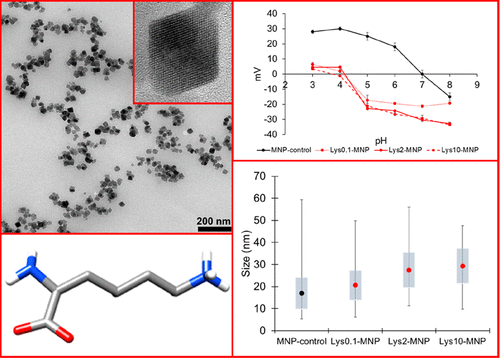当前位置:
X-MOL 学术
›
Cryst. Growth Des.
›
论文详情
Our official English website, www.x-mol.net, welcomes your feedback! (Note: you will need to create a separate account there.)
Lysine as Size-Control Additive in a Bioinspired Synthesis of Pure Superparamagnetic Magnetite Nanoparticles
Crystal Growth & Design ( IF 3.8 ) Pub Date : 2020-01-15 , DOI: 10.1021/acs.cgd.9b00169 Rafael Contreras-Montoya 1 , Ylenia Jabalera 2 , Víctor Blanco 1 , Juan Manuel Cuerva 1 , Concepcion Jimenez-Lopez 2 , Luis Alvarez de Cienfuegos 1
Crystal Growth & Design ( IF 3.8 ) Pub Date : 2020-01-15 , DOI: 10.1021/acs.cgd.9b00169 Rafael Contreras-Montoya 1 , Ylenia Jabalera 2 , Víctor Blanco 1 , Juan Manuel Cuerva 1 , Concepcion Jimenez-Lopez 2 , Luis Alvarez de Cienfuegos 1
Affiliation

|
Magnetite nanoparticles (MNPs) are being used in a number of nanotechnological applications, especially biomedical, both in diagnosis and in therapeutics such as hyperthermia agents and as drug nanocarriers for targeted chemotherapy. However, the development of efficient methodologies to produce novel MNPs with the specific requirements needed for biomedical applications is still challenging. In this context, biomimetic approaches taking use of magnetosome proteins expressed as recombinant and/or polyamino acids are becoming of great interest. In fact, these protocols give rise to magnetite nanoparticles of adequate size, magnetic properties and surface functionalization that make them compatible for biomedical applications. In this respect, herein we show for the first time that lysine (Lys), unlike other amino acids like arginine (Arg), is able to exert a control over the size of MNPs produced in water and at room temperature. This control occurs through the stabilization of the magnetite nuclei by the lateral ammonium group of Lys. The strength of such stabilization allows a further release of these previously bonded nuclei to allow the further growth of the larger ones, thus resulting in larger crystals compared to those obtained by using Arg or no amino acids at all. MNPs obtained by the mediation of this amino acid are fairly large (30 nm) while being superparamagnetic at room temperature. They present an isoelectric point of 4, which may allow the coupling/release of these MNPs to other molecules based on electrostatic interaction, a large magnetic moment per particle and high magnetization saturation. This study highlights the effects that biological additives have in the process of magnetite biomineralization and goes along the line of previous reports using magnetosome proteins and polyamino acids.
中文翻译:

赖氨酸在纯超顺磁性磁铁矿纳米粒子的生物启发合成中作为尺寸控制添加剂。
磁铁矿纳米颗粒(MNP)已用于诊断和治疗(如热疗剂)以及靶向化学疗法的药物纳米载体等许多纳米技术应用中,尤其是生物医学。然而,开发有效的方法以生产具有生物医学应用所需的特定要求的新型MNP仍然具有挑战性。在这种情况下,利用表达为重组氨基酸和/或聚氨基酸的磁小体蛋白的仿生方法变得非常受关注。实际上,这些协议产生了具有足够大小,磁性和表面功能化的磁铁矿纳米颗粒,使其与生物医学应用兼容。在这方面,我们首次展示了赖氨酸(Lys),与其他氨基酸(如精氨酸(Arg))不同,能够控制水中和室温下产生的MNP的大小。这种控制是通过Lys的侧铵基团稳定磁铁矿核而实现的。这种稳定的强度允许这些先前键合的核进一步释放,从而允许更大的核进一步生长,因此与使用Arg或完全不使用氨基酸获得的晶体相比,晶体更大。通过这种氨基酸介导获得的MNP相当大(30 nm),而在室温下却是超顺磁性的。它们的等电点为4,这可以基于静电相互作用,每个粒子较大的磁矩和较高的磁化饱和度而允许这些MNP与其他分子偶联/释放。
更新日期:2020-01-16
中文翻译:

赖氨酸在纯超顺磁性磁铁矿纳米粒子的生物启发合成中作为尺寸控制添加剂。
磁铁矿纳米颗粒(MNP)已用于诊断和治疗(如热疗剂)以及靶向化学疗法的药物纳米载体等许多纳米技术应用中,尤其是生物医学。然而,开发有效的方法以生产具有生物医学应用所需的特定要求的新型MNP仍然具有挑战性。在这种情况下,利用表达为重组氨基酸和/或聚氨基酸的磁小体蛋白的仿生方法变得非常受关注。实际上,这些协议产生了具有足够大小,磁性和表面功能化的磁铁矿纳米颗粒,使其与生物医学应用兼容。在这方面,我们首次展示了赖氨酸(Lys),与其他氨基酸(如精氨酸(Arg))不同,能够控制水中和室温下产生的MNP的大小。这种控制是通过Lys的侧铵基团稳定磁铁矿核而实现的。这种稳定的强度允许这些先前键合的核进一步释放,从而允许更大的核进一步生长,因此与使用Arg或完全不使用氨基酸获得的晶体相比,晶体更大。通过这种氨基酸介导获得的MNP相当大(30 nm),而在室温下却是超顺磁性的。它们的等电点为4,这可以基于静电相互作用,每个粒子较大的磁矩和较高的磁化饱和度而允许这些MNP与其他分子偶联/释放。


























 京公网安备 11010802027423号
京公网安备 11010802027423号